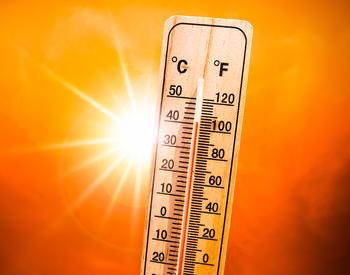Sometimes it’s just satisfying to see things for yourself. That opportunity was given to me during the great heat wave in the Pacific Northwest in June 2021 during which the temperature rose to 116°F (47°C) in Portland, Oregon, on the hottest day.
I have always read that honey bees maintain their brood chambers between 85° to 95°F (30°–35°C) throughout the year, regardless if the outside temperature is below freezing or in the triple digits. In the summer, the brood temperature range is even narrower, often between just 92° to 95°F (33°–35°C). Temperatures above 96°F (36°C) have been shown injurious or fatal to developing brood.
Last year, I installed a hive monitoring system in one of my backyard honey bee colonies, just for fun and education. A partner of mine, Ed Bunch, did the same. These systems record temperature in the brood box, humidity and hive weight over time. These are not necessarily the most accurate instruments that can be used, but accurate enough to show trends and enable decision-making.
I knew the heat wave was coming and that record temperatures (>110°F/43°C) were forecast so I anxiously waited to see how the bees would cope. Could they manage to actually lower the inside air temperature of their hives by 15°F degrees (8°C) or more? And could they do this while the walls of their hives were being blasted by the baking sun, making the task even harder?
I was not disappointed for excitement — the bees put on a show and we got our temperature data. Yes, all colonies but one held the upper limit in the brood chamber to less than 97°F (36°C) for the entire period.
Meanwhile, I was able to admire thousands of HVAC engineers working diligently to maintain equilibrium. There was lots of bearding, fanning, shuffling, water collecting and very prolonged days of flight activity. The bees kept foraging for the duration and even made several pounds of honey (which actually helped cool the hive with the evaporative process).
It has been known for some time that honey bees, despite being “cold blooded animals,” are able to modify their individual temperatures as well as their collective nest temperatures. Heat generation is done primarily by shivering their flight muscles, but cooling uses several techniques such as fanning inside and outside the hive, formation of ventilation channels, dispersal (keeping distance from one another), evaporative cooling by fanning water and nectar placed on internal surfaces (e.g., comb), and “tongue lashing,” the repeated extension and retraction of the proboscis holding a thin film of fluid.
During flight, honey bees have been shown to “tongue lash” which serves to cool their hot thorax muscles. This type of flight cooling has also been reported in other bees such as Bombus vosnesenskii, Xylocopa varipuncta, and Centris pallida.
I used to work in the Nevada desert and I was amazed at how well evaporative (swamp) coolers work to lower air temperature. They were so much less expensive to run than refrigerated air conditioners. All you need is water flow over a substrate, airflow, and an air temperature to dew point gradient; the latent heat of evaporation does the rest. Honey bees have most likely been utilizing these principles for millions of years — the amazing HVAC specialists they are.
Footnotes
Ed's Hive3 showed a temperature excursion over 100°F (38°C) for about 1½ hours at the beginning of the heat wave (June 26 around 2 p.m.), but those levels never returned even as temperatures rose. Instrument capability might also have played a role as data in this period showed some anomalies.
References
Mark L. Winston. The Biology of the Honey Bee. 1987. Harvard University Press
Bernd Heinrich and Harald Esch. Thermoregulation in Bees. American Scientist, Vol. 82, No. 2 (MARCH-APRIL 1994), pp. 164-170
Roberts, S. P., & Harrison, J. (1998). Mechanisms of Thermoregulation in Flying Bees. American Zoologist, 38(3), 492-502.
Edward Southwick, The Hive and Honey Bee. 2015 Edition. Chapter: Physiology and Social Physiology of the Honey Bee. Dadant Publication
Data:
Placement of the single temperature sensor in the brood chamber may not always have been ideal. Brood nest centers often move so sensor placement can be suboptimal. In our situations, temperature sensors were deemed to be properly placed “in the brood nest” upon initial installment.
Granted, the temperature measurement accuracy of the instruments used in this study could be greatly improved. The MG hive had a sensor (DHT11) accuracy of +/- 3.6°F. Ed’s hives were better outfitted with a sensor (BME280), accuracy of +/- 1.8°F. Nevertheless, I believe all measurement data is valid at the “gross reality check” level and acceptable for evaluation.
PDX temperature data was provided by the Weather Underground and measured at the Portland International Airport Station. The beehives measured in this study are located in Beaverton and Hillsboro, about 13 to 16 miles from PDX, respectively. It is possible that temperature data may have differed by one or two degrees (F) depending on location. Data was measured and collected by BeeCorders and transmitted to ThingSpeak for storage and graphing.
Materials:
BeeCorder Hive Monitor: Rev0. Brainchild of Steen Larsen.



















